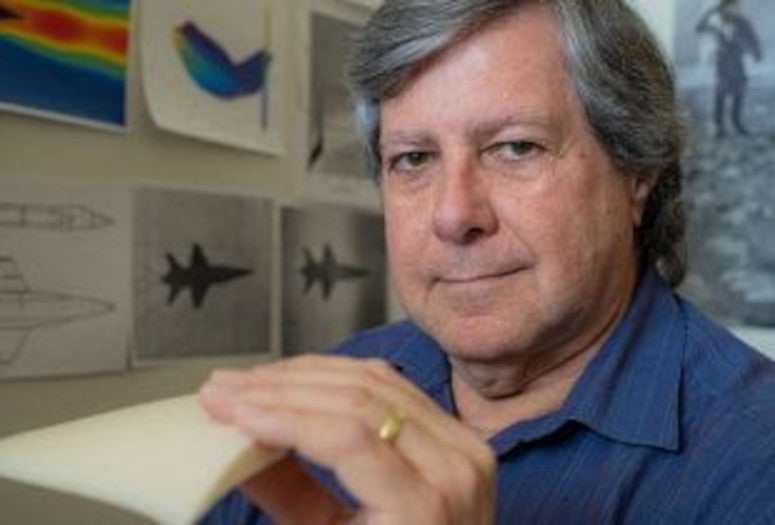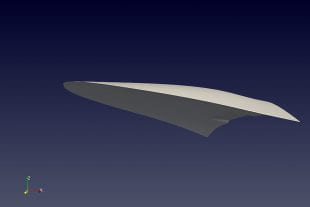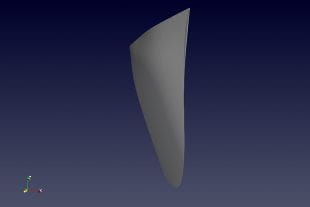HOUSTON – (April 10, 2020) – Patrick Rodi's new idea for surfing is far out, fast and white hot.
Rodi, a pioneering aerospace engineer who joined Rice University's Brown School of Engineering in 2018, has designed a high-flying vehicle called a "capsule waverider" that does more than catch a wave. It survives a fiery return from outer space before gliding like a surfer on its own shock wave.
The waverider is far from a typical airplane. While an airliner might fly about 600 miles an hour, the hypersonic waverider would be at least 10 times faster, and at such speeds the air flowing around an aircraft behaves in ways that are fundamentally different from how air flows around a conventional airplane.
"When you have hypersonic flow, you generate shockwaves," said Rodi, a professor in the practice of Rice's Department of Mechanical Engineering. "As a designer, you can choose the shape of that geometry such that the shock wave lies right along the vehicle's leading edge. So it's literally riding its own shock wave."
Rodi joined Rice after a 23-year career at Lockheed Martin, where he worked on many advanced programs at the famed Skunk Works in Palmdale, California, as well as on the Orion space capsule program in Houston. Waveriders have long been a passion for Rodi, who the Office of Naval Research has called "the most prolific waverider technology developer in the public record."
"Other vehicles have shock waves," he said. "But the shock waves are separated from the vehicle, and high-pressure leaks around that little gap between the shock wave and the body itself."
The waverider design stops the high-pressure air from leaking away.
"You're expending energy to compress the air, and now you're using that high-pressure air as efficiently as possible," he said. "You're not losing that lift. You're capturing it by shaping the geometry, riding the wave. And it's very efficient. That's the big thing about waveriders. The lift-to-drag ratio is really high, which correlates linearly with gliding distance, or range, the metric you're looking for."
Rodi was scheduled to present the capsule waverider design last month in Montreal at the American Institute of Aeronautics and Astronautics (AAIA) Space Planes and Hypersonic Systems and Technologies Conference, which was canceled due to the coronavirus.
"This is my sixth new class of waverider vehicles, and it's what is known as a boost-glide vehicle, which is a big deal in hypersonics these days," he said.
Boost-glide vehicles can be either long- or short-range and are often discussed as a new type of delivery system for weapons launched from ballistic missiles.
Like traditional warheads, boost-glide vehicles would be boosted into space on missiles. But traditional warheads do not maneuver, which means that it's possible to tell where they are headed just a few moments after they are launched. Boost-gliders can stymie defenders by changing direction and flying to unpredictable target locations.
"When it first enters the atmosphere, it punches pretty deep, and it gets really, really hot," Rodi said. "There's high-pressure loading, high heating. For re-entry you want something that can survive that high heating. Basically, you want a vehicle that kind of looks like a traditional space capsule. As a glider, you want something that's very efficient, with a high lift-to-drag ratio."
The capsule waverider class balances those demands, he said. On one side, it has the rounded, blunt shape reminiscent of a traditional space capsule heat shield. On the opposite side, it is a wing-shaped waverider glider.
Weapons weren't the inspiration for Rodi's boost-glide waverider. Rather, he envisions them as vehicles for landing people and supplies on Mars.
While the red planet's atmosphere is thin, spacecraft need heat shields to survive entry. This heating, the planet's rock-strewn surface and the communications lag between Earth and Mars combine to make landings on Mars very difficult.
"That's a real problem for NASA," Rodi said. "This concept would allow you to come in as a capsule, flip over to a waverider, glide around, look things over, find your landing spot and then either drop off equipment with parachutes, glide in and skid across the Martian surface, or pitch up and land on the vehicle's tail. It gives you a lot of options."
Rodi was a Lockheed Martin Fellow, a distinction awarded to fewer than 1% of the company's employees, and is an associate fellow of the AAIA and the director of a new Rice program that allows professional masters students to specialize in aerospace engineering. For more information about Rice's Professional Master of Mechanical Engineering Aerospace Track, visit: https://mech.rice.edu/graduate-program/professional-masters.
-30-
High-resolution IMAGES are available for download at:
https://news-network.rice.edu/news/files/2020/03/0330_WAVERIDER-pr24-lg.jpg
CAPTION: Rice Engineering Professor Patrick Rodi with a 3D printed model of the "capsule waverider," a hypersonic vehicle he designed to glide like a surfer on its own shock wave. (Photo by Jeff Fitlow/Rice University)
https://news-network.rice.edu/news/files/2020/04/0330_WAVERIDER-rodi-lg.jpg
CAPTION: During his 23-year career at Lockheed Martin, Rice Engineering Professor Patrick Rodi worked on advanced programs at the famed Skunk Works in Palmdale, California, and on the Orion space capsule program in Houston. (Photo by Jeff Fitlow/Rice University)
https://news-network.rice.edu/news/files/2020/04/0330_WAVERIDER-bor-lg.jpg
CAPTION: In its boost orientation, the capsule waverider has the blunt shape reminiscent of a traditional space capsule heat shields. (Image courtesy of P. Rodi/Rice University)
https://news-network.rice.edu/news/files/2020/04/0330_WAVERIDER-gor-lg.jpg
CAPTION: An illustration of the capsule waverider in glide orientation. (Image courtesy of P. Rodi/Rice University)
This release can be found online at news.rice.edu.
Follow Rice News and Media Relations via Twitter @RiceUNews.
Located on a 300-acre forested campus in Houston, Rice University is consistently ranked among the nation’s top 20 universities by U.S. News & World Report. Rice has highly respected schools of Architecture, Business, Continuing Studies, Engineering, Humanities, Music, Natural Sciences and Social Sciences and is home to the Baker Institute for Public Policy. With 3,962 undergraduates and 3,027 graduate students, Rice’s undergraduate student-to-faculty ratio is just under 6-to-1. Its residential college system builds close-knit communities and lifelong friendships, just one reason why Rice is ranked No. 1 for lots of race/class interaction and No. 4 for quality of life by the Princeton Review. Rice is also rated as a best value among private universities by Kiplinger’s Personal Finance.




